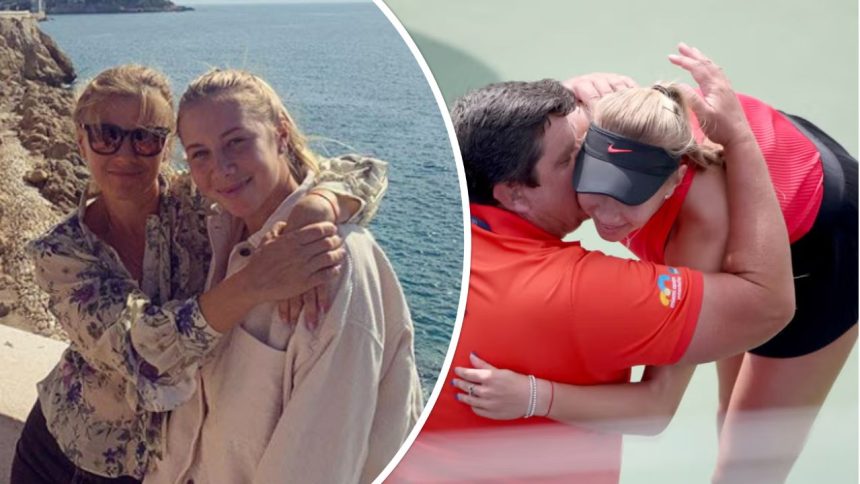Every great athlete has a story, but Amanda Anisimova’s isn’t just about forehands and trophies; it’s about a family who crossed oceans and rebuilt their lives for a dream they didn’t even know was theirs. Long before she stunned the tennis world with her explosive backhand or became the youngest American semifinalist at Roland Garros in over a decade, Amanda was just a little girl in Florida, hitting balls with her dad on public courts while her mom juggled the chaos of raising two tennis-obsessed daughters.
The Anisimovs weren’t a dynasty. They weren’t wealthy. They were immigrants who believed in hard work, loved fiercely, and when tragedy struck, held on tighter. This is their story as much as hers.
You Might Like: Is Linda Yaccarino Jewish? Her Parents, Ethnicity & Religion
The Backbone of a Champion: Olga and Konstantin Anisimova
Amanda Anisimova’s rise in tennis isn’t just a story of raw talent; it’s a tale shaped by her parents, Olga (mother) and Konstantin (father), two Russian immigrants who bet everything on the American dream. They weren’t tennis pros. They didn’t grow up with rackets in their hands. But when their daughters showed promise, they dove headfirst into the sport, turning their family’s life into a whirlwind of courts, coaches, and cross-country moves.
The smile on her face!
Amanda Anisimova takes down Anastasia Pavlyuchenkova 6-1, 7-6(9) to reach her first #Wimbledon semi-final pic.twitter.com/8QMwLHtGap
— Wimbledon (@Wimbledon) July 8, 2025
Olga, a former accountant in Moscow’s banking system, and Konstantin, who also had a financial background, left Russia in 1998 with their older daughter, Maria, seeking better opportunities in the U.S. They settled in New Jersey, where Amanda was born in 2001, but soon relocated to Florida, the mecca of junior tennis, when Amanda was just three. The move wasn’t for them; it was for Maria, who was already deep into the sport. But little did they know, their younger daughter would become the one to carry the family’s tennis legacy to the world stage.
Konstantin became Amanda’s first coach, teaching her the basics with a simple philosophy: “When you play, you have to compete, but you have to enjoy. It’s a beautiful day, people came to see you play—just have fun.” That balance of discipline and joy defined Amanda’s early years. By age two, she was already swinging a racket, and by seven, her technique was so natural that Olga once said, “No one touched her. That was the development.” There was no forced push, just a kid who loved the game, guided by a father who refused to let the pressure crush her spirit.
Olga, meanwhile, played a different role. When Amanda skipped traditional school to focus on tennis, her mom opened a tennis camp, not just for training, but to give her a social life. “Many of her friends today are friends from that camp,” Maria later shared. It was a small but crucial detail in Amanda’s journey: her parents weren’t just building a player; they were raising a happy, well-rounded person.
Tragedy, Triumph, and the Unbreakable Bond
New post!
Konstantin Anisimov, father of Amanda Anisimova, found dead
– https://t.co/r6cqlA0tZy pic.twitter.com/I7jtxh1JAd
— Tennis.Life (@tennislifenews) August 20, 2019
In August 2019, just days before Amanda’s 18th birthday and the US Open, Konstantin died suddenly of a heart attack. The loss shattered her. She withdrew from the tournament, and for months, grief weighed heavier than any opponent. “It was the worst thing that ever happened to me,” she admitted. Tennis, the thing that had always connected them, now felt unbearable. But slowly, she returned, not just for herself, but for him. “I try to make him proud,” she said. Every win, every comeback, became a tribute.
Olga stepped in as a stabilizing force, but Amanda’s path wasn’t linear. She took a mental health break in 2023, battling burnout, and turned to painting as an outlet. Some of her artwork even ended up in a New York gallery as part of an “Art for Hope” project. When she returned to tennis, it was with a renewed sense of purpose and it showed.
Also See: What Is Linda Yaccarino’s Net Worth and Salary in 2025?
Fast-forward to July 2025: Amanda, now 23, is in the Wimbledon semifinals, her best run since her 2019 French Open breakthrough. After a nail-biting quarterfinal win over Anastasia Pavlyuchenkova, she collapsed on the grass, then hugged her family in the stands—her mom, her sister, even her nephew Jackson, whose fourth birthday was just around the corner. The moment was pure joy, a full-circle celebration of the people who’d been there from the start.
The Legacy They Built
Today, Amanda’s success is a credit to her parents’ sacrifices. Konstantin’s coaching laid the foundation, but his real gift was teaching her to love the game. Olga’s quiet strength kept the family grounded through every high and low. And while Konstantin isn’t here to see his daughter break into the top 10 after Wimbledon, his influence is everywhere—in her powerful groundstrokes, her resilience, and the way she still talks about making him proud.
As she prepares to face world No. 1 Aryna Sabalenka in the semifinals, one thing’s clear: Amanda Anisimova isn’t just playing for titles. She’s playing for the two people who turned a childhood dream into a legacy. And win or lose, that’s what makes her story unforgettable.



